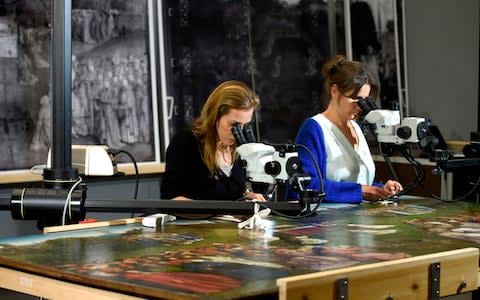True 'intense' face of Belgium's Mystic Lamb revealed after 600 years

The intense and soulful true face of Belgium’s Mystic Lamb, the central figure of a world-famous 15th century Flemish alterpiece, has finally been revealed after almost six centuries.
The Adoration of the Mystic Lamb, one of the world’s most stolen artworks and oldest oil paintings, was created in 1432 by Jan Van Eyck and his brother Hubert, leading artists of the influential Flemish Primitives. The giant alterpiece, which features hinged panels depicting Bible scenes and daily life, is on display in St Bavo’s Cathedral in Ghent.
It was revealed this week after a painstaking restoration that tourists visiting the cathedral over the last 600 years have been gazing at a completely different lamb’s face to the original, which was overpainted in the 16th century to become an “impassive rather neutral figure”.
"The head is very different from what we've known since the 16th century. It depicts a lamb which is much more intense and expressive, which connects far more directly with the people, with big eyes," restoration project leader Helene Dubois said.

Koenraad Jonckheere, professor of Baroque art at Ghent University told Flanders Today that the overpainting, “subtly adapted the shapes to the taste of the time and to some extent neutralised the Van Eycks’ intense and humanised identification of the Lamb into an expressionless animal, seemingly unaffected by what was about to come.”
The original, by contrast, has more personality and sports “an intense gaze and is characterised by a graphically defined snout and large, frontal eyes, drawing onlookers into the ultimate sacrifice scene”.
It was not the only time that the 20 panel alterpiece, of which 40 percent was overpainted, has suffered an indignity. A partial restoration in 1951 revealed the lamb’s original ears but techniques were not advanced enough to complete the work, leaving the lamb sporting four ears for nearly 70 years.

Over the years the 15 foot by 10 feet masterwork has been split into pieces, seized by Napoleon and the Nazis and stolen by thieves. In a mystery that has baffled detectives for decades, one of its 12 panels is still missing after a daring heist in 1934.

A week ago, Ghent’s public prosecutor urged people not to dig up the city’s beautiful cobbled squares after the author of a new book suggested the panel may be buried underneath one of them.
The full restoration of both sides of its hinged panels is due to be complete by the end of 2019, in time for the start of a year of celebrations of Jan Van Eyck.

 Yahoo News
Yahoo News 
